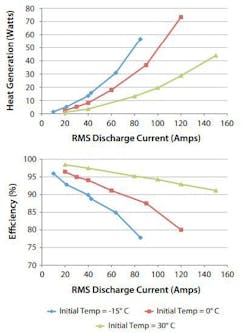EV Batteries: Designing in Safety and Longevity
Members can download this article in PDF format.
What you’ll learn:
- The sources and severity of EV battery fires.
- Design ideas that can reduce the hazards.
- Emerging technology that may help reduce such hazards in the future.
Electric vehicles (EVs), most of them dependent on lithium-ion battery cells, are everywhere, from cars and trucks to scooters and bicycles. And as much as they’re popular, one of the design challenges that’s getting public and media attention as well as the eye of regulators is the specific fire risks associated with the technology.
While vehicles that rely on combustible fuel always have fire risks, the intense fires associated with lithium-ion batteries have been alarming to consumers and others. For example, in a recent report, the National Fire Protection Association noted, “High-voltage (HV) battery fires may take much longer to extinguish than conventional fires, and the resulting smoke is toxic.”
Designing Safer EV Battery Systems to Mitigate Thermal-Runaway Risks
Anything engineers can do to design features into battery packs and battery-management systems (BMS) to prevent, contain, or extinguish EV battery fires meets a growing market demand and can reduce liability risks down the road. Furthermore, this care can also help ensure that temperatures are monitored and maintained at an optimal level for battery health and operational efficiency.
Some in the industry are focusing on improving manufacturing quality related to cells and batteries. A recent paper proposed that AI and “cobots” be employed in cell and pack manufacturing to improve the quality and thoroughness of inspections, as well as gather information that could be used to further improve performance and reliability. But for now, that’s just a proposal.
Others are looking at specific failure scenarios. At the University of Maryland, for example, researchers have created a new technique for lithium-ion battery improvement that inhibits lithium dendritic growth, (the small needle-like structures that can develop inside lithium-ion cells). The dendritic structures may lead to electrical failures and even fires, but the new method proposes adding an interlayer to reduce this risk.
Tech Advances in Battery-Management Systems for Lithium-Ion Batteries
The National Renewable Energy Laboratory has also done extensive research on cell and pack failure modes. NREL developed an Isothermal Battery Calorimeter, an award winning approach to the topic as outlined in a government fact sheet (see figure). It fine-tunes understanding of heat sources and heat stresses on cells and packs, enabling engineers to develop more robust physical and electrical designs.
A substantial number of recent patent applications also offer ideas on how to reduce the risk of thermal runaway. Fortunately, both new technologies and existing best practices can help design engineers to create more rugged, robust, and safe EV battery systems.
On the new technology side, BMS can get and are becoming more sophisticated, with better sensors and more intelligence to help reduce cell stress and damage and prevent catastrophic thermal runaway.
For example, Metis Engineering offers a Controller Area Network (CAN)-based “Production Battery Safety Sensor,” intended for inclusion in a battery pack that can detect and provide alerts regarding a thermal runaway, in some instances perhaps before other technologies.
The sensor “sniffs” volatile organic compounds in the battery pack, and monitors pressure change, humidity, and dew point. It also (optionally) can include an accelerometer to detect physical shock loads of up to 24G while monitoring the duration of such events. Data is shared via a CAN interface with electronic control units (ECUs) or other relevant devices.
Addressing Failure Scenarios in EV Batteries
In addition to the cells themselves, the connection system between cells cany exhibit characteristics that contribute to high heat. A busbar, for example, may be operating well within acceptable ratings and yet still contribute an undesirable level of heat to the battery-pack environment.
All connectivity components must be considered carefully to reduce heating through their intrinsic properties and in terms of how they can help to dissipate heat.
Heat management and fire suppression, not directly an electrical matter but an area that bears on performance and safety, tend to overlap. A cell failure can create a hotspot, which means both insulation and heat-dissipation properties are needed.
Design choices for handling thermal issues can range from air gaps and aerogels to ceramics and flexible graphite. These choices have immediate consequences in terms of bulk, weight, and cost. Practical choices are encouraged by the need to meet a generally accepted minimum safe escape time of five minutes for human occupants.
Other considerations include recognizing that the act of adding insulation can inadvertently contribute to increasing heat within the battery pack and potentially interfering with cooling. This challenge worsens during fast charging.
Employing a dielectric fluid largely solves the problem of overheating cells and uneven cooling and can even suppress fire. However, it also has weight, cost, and complexity challenges.
State-of-charge (SOC) information, which aims to define the “fully charged” condition of each cell voltage, requires that current and temperature of each cell must be measured as accurately as possible—something that’s often easier said than done. Best results depend on reducing the resistance in the sense circuits as much as possible.
The lead length to each cell generally varies, but it must always be reduced to practical minimums. Connections need to be electrically sound as well as be able to stand up to thermal and mechanical stresses (as the cells themselves change shape and dimension during charge and discharge cycles, or as G forces to the vehicle impact the battery pack).
Critical cell state-of-health (SOH) calculations depend on good data. Batteries below 80% in SOH calculations are at the limit of usability. And, of course, in a serial circuit, the “weakest link” is a real problem that must limit the performance of the whole.
As can be seen from the above, thermal management and prevention of thermal runaway is mostly a matter of getting many small things right rather than implementing a single “solution.”



